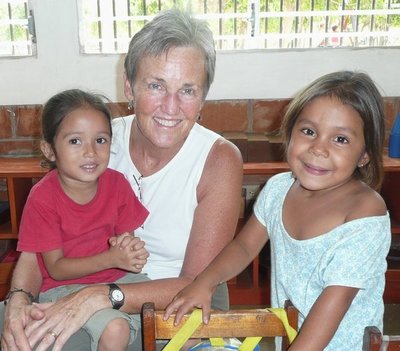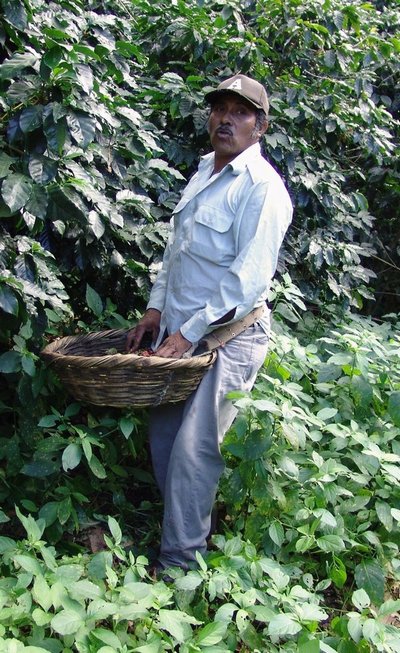June 25, 2009
Toward a better basket: UW lecturer travels Nicaragua to promote ergonomic reform for coffee harvesters
By Elizabeth Sharpe
Environmental & Occupational Health Sciences
As Seattle coffee drinkers sip their brew, they may not realize that Nicaraguan coffee harvesters risk injury to bring the precious beans in for processing. Each harvester carries a large, shallow basket at the waist that not only puts pressure on the back, but also forces them to reach out further to get the beans — an ergonomic nightmare.
But UW Lecturer Kate Stewart hopes to change that situation by working with the harvesters to design a new basket that will allow them to do their jobs without getting hurt. The change will have a significant impact in Nicaragua, where coffee provides agricultural jobs and supports more than 45,000 families who own coffee farms.
Stewart already has support from both management and harvesters, as well as contacts to make a prototype basket. That’s because she’s been to Nicaragua before.
In fact, Stewart just returned in April from five months as a Fulbright Scholar in Nicaragua, a role akin to a “citizen diplomat,” she said. Fulbright is an educational program sponsored by the U.S. Department of State and designed to bring people from different countries face-to-face and improve America’s foreign relations. Grantees lecture and conduct research in a wide variety of fields.
“When you put a face on a country, it makes such a difference,” said Stewart, who is an expert in ergonomics, which is the study of redesigning a job, equipment, and workplace to better fit the worker and to prevent injury caused by repetitive motion. She teaches graduate courses in ergonomics and safety in the Department of Environmental and Occupational Health Sciences.
In Nicaragua, where most work depends on strong bones and brawn, musculoskeletal disorders are a serious problem, and one of the leading causes of occupational injuries. When factories are lucky enough to own machinery, the tools are often designed for taller, larger-sized people such as in the U.S.
In spite of rudimentary materials and major problems and inconveniences, Stewart said, “people have this uncanny ability to move on. Everything is appreciated.”
This past year wasn’t the first time Stewart had been to Nicaragua. She took her first road trip in 1972, traveling all through Mexico and Central America. And then five years ago, Stewart connected with Dr. Aurora Aragón and co-taught with another Washington-based ergonomics expert three week-long ergonomics courses in Central America via the UW Collaborative Center for Healthy Work and Environment. Aragón heads the Centre for Research on Health, Work, and Environment at the Universidad Nacional Autónoma de Nicaragua (UNAN) in León, the second largest city in the country. Aragón also runs the only occupational medicine clinic in Nicaragua and is the force behind the active Preventative Medicine program within UNAN’s School of Medicine.
Only, Stewart felt continuous time in Nicaragua was needed.
“To be able to really make an impact, I needed to do more training and to do more follow-up. Projects that improve ergonomics are not a one-shot effort,” said Stewart. Ongoing feedback, support, and follow-up make a program sustainable.
She calls herself “an activist with a passion for doing the right thing.”
“I’ve always been working or volunteering for organizations that contribute in some way. It’s part of who I am. I want to make things better.”
And so, the collaboration with Aragón led to the Fulbright. Stewart packed her Subaru Forester and headed down the Pan-American Highway, through Mexico, Guatemala, El Salvador, Honduras. “It was wonderful, just great, and I met wonderful people.”
In Nicaragua, Stewart taught an applied ergonomics course in Spanish to working professionals and university faculty. Called a Diplomado, the intensive coursework is equivalent to half a master’s degree. Every ergonomics concept taught in the classroom, Stewart said, she assigned the students in her class to look for on the streets of León.
To complete the degree, each Diplomado candidate must complete an ergonomics-based thesis project. For example, a surgeon in the class is working with an organization that hires disabled workers to build prostheses, wheelchairs and other devices for others with disabilities. The devices are needed for the countless numbers of people in the country born with deformities from toxic exposures or those shot or maimed during the Sandinista Revolution in 1979 and the Contra War against the Sandinista government that soon followed. Among other ergonimics improvements in the workshop, the surgeon is working hand in hand with the disabled workers to construct a device to bring their work off of the floor. This simple, inexpensive change will eliminate the need to work in awkward positions.
Stewart inspired another student in the class, an engineer who heads the industrial hygiene and safety division within Nicaragua’s Ministry of Work to lobby his own boss, the health and safety director, to consider including ergonomics as a part of their existing safety regulations. The director reports to the minister of work, head of a ministry similar to the U.S. Department of Labor, who can influence high-level decisions.
The engineer’s connection, along with Aurora Aragón’s reputation, opened a perfect opportunity. Stewart went with Dr. Lylliam López, a student in Stewart’s class and on the UNAN’s medical school faculty, to meet with the health & safety director.
“I talked about what we knew in the U.S., about the clear relationship between poorly designed work and injuries and the cost of doing nothing and the toll it takes on both the workers and the bottom line,” recalled Stewart. “And I talked about what we’ve seen, our experience in Washington state, and that an effective way to ensure worker safety and health is through legislation.”
Currently, no other developing country in the world has measures to minimize musculoskeletal exposures. “Nicaragua has a government leaning more on the side of the worker, and they’d be the first [to initiate federal measures] . . . they liked that,” said Stewart. Plus, making operations safer would mean that workers would be able to improve, even increase production.
The meeting led to the formation of a sub-commission to provide guidance to the federal government on ergonomics regulation. Lopez sits in on all the meetings, said Stewart, who relays information to her. The sub-commission, said Stewart, “will create something palatable that they can hand off to the National Congress when they vote on the measure in November.”
Back in the U.S., Stewart continues the momentum, talking with López regularly about the sub-commission and about the ergonomics classes López will begin teaching in UNAN’s medical school. Stewart has started to receive 40-page reports from her class of 16 students on their thesis projects. No longer sponsored by Fulbright or any other funding source, she explained the work as “my love for Nicaragua.”
“Nicaragua is the country under my skin. I will continue to go back there,” she said.


